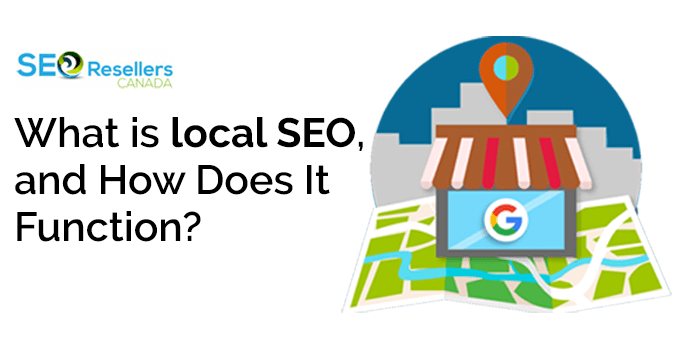To launch a new website, there are plenty of moving parts that need to be taken care of, including web development, design and even branding.
While staying focused on these factors, people tend to consider search engine optimization (SEO) as an afterthought, which isn’t a good decision, by the way.
In fact, white-label SEO should be your priority to ensure the new website is created in adherence to search engine norms and standards.
If you have noticed, you might know that well-established SEO consulting agencies tend to highlight SEO marketing as the key element of their web development package.
Why is that? Well, a report published by BrightEdge in 2019 stated that 68% of digital experience begins from search engines. The same study also claims that 53.3% of all website traffic originates from organic searches. Thereby clearly stating the importance of SEO.
Besides, keeping SEO for later can be an uphill battle. Instead, use this holistic SEO checklist to save yourself a lot of valuable time and experience the benefit of SEO sooner than later.
1- What is the role of SEO in website development?
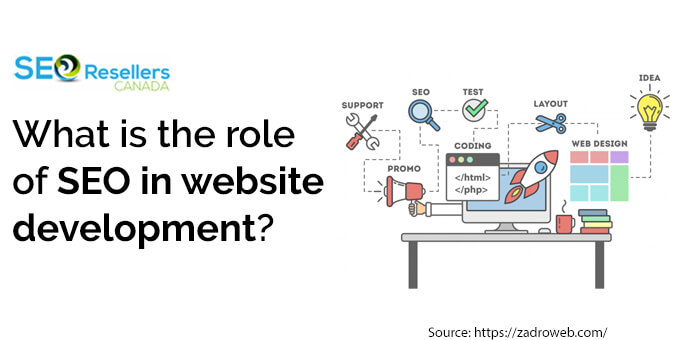
Similar to how a new business is like a baby to every entrepreneur, so should the website be. A new website in the digital realm is like an infant baby – one that cannot comprehend the language (no indexed pages), has no friends (no backlinks) and has zero social skills (no authority).
As time evolves, search engines like Google tend to make changes to a website that has been around for longer. It assumes that the SEO is done right. You will soon start noticing increased competition for your website.
With an impactful and high-level SEO strategy in place, you certainly would not have to worry about this competition. However, the sooner the SEO strategy is implemented, the better.
Hence, focusing on low-competition, long-tailed keywords until the website evolves should be mission-critical.
You can eventually work your way up to a full-fledged SEO keyword strategy over time. Some SEO TLC from the first day of website development can help in creating a site capable of competing and even overtaking the strongest competitor in your industry.
2- What are some solid ways to develop a solid SEO strategy for a new website
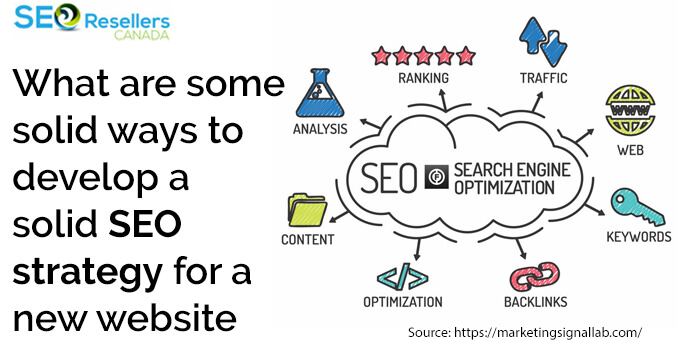
Proven tips for transforming your novice website into an advanced website that is capable of beating the ever-expanding competition.
2.1- Study your competition
Once you are done with the basic things, which are –
- Choosing the right domain name
- Selecting a high-speed website hosting provider
- And setting up Google Search Console (GSC),
You should start studying your competitors. As an essential, find answers to the following questions during your search phase –
- What are the core similarities between you and your competitor’s company? What are the differences? What are their USPs (unique selling points)?
- Do they have a solid SEO content marketing strategy in place? If yes, what do they write about?
- What keywords does their website get ranked for?
A critical thing to consider here is the SEO competitors. There are many businesses that deal with the same products and services. However, that doesn’t mean you should copy-paste their SEO marketing strategy in hopes of outperforming them. It isn’t a feasible choice.
Your notion should be determining competitors0 who sell similar stuff as you or write similar content as you and are using keywords similar to you. These competitors are your actual SEO competitors. And they are the ones who you want to beat.
On comprehending the SEO competitors, your focus should turn to perform a keyword gap analysis. These are the keywords you need to cover in order to outrank your competitors.
Here are some tips for effectively performing a keyword gap analysis –
- Use an SEO tool like Moz and add your and your chosen competitor’s root domains.
- Now review the shared and overlapped keywords.
- Export the report into spreadsheet and filter keywords that are appropriate to be used on your site.
- Lastly, start using these keywords to build your new SEO strategy for 2022 and 2023.
2.2- Focus on keyword research and generate a keyword map
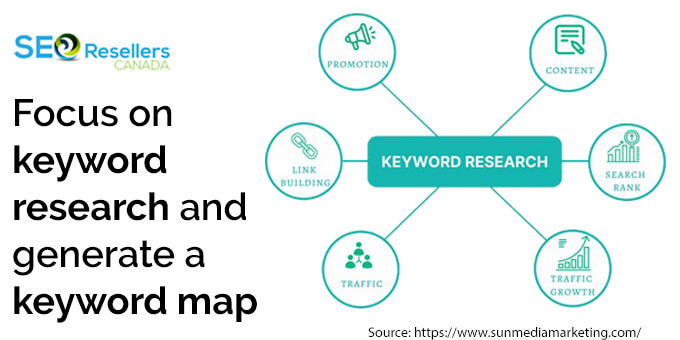
Keywords are the heart of every SEO strategy. They connect the search queries to the content listed in the search engine result pages (SERPs).
The search engine’s goal is to employ the keywords utilized in the search queries to determine and provide the most relevant information to the searchers, also known as the search intent.
Once search engines like Google determine the search intent of a user, it shows businesses or services that match the search criteria. This same concept is used by Google on a daily basis for every type of search made – whether it is related to buying groceries, finding information on nearby eateries and so on.
2.2.1- Role of search intent in the buyer’s journey
Comprehending search intent can go a long way, especially in identifying the buyer’s journey stages. Hence, your focus when crafting content or building an SEO link-building strategy should be on creating information that benefits their awareness, consideration and decision stage.
For instance, if someone searches “what are the best places for dining?” you wouldn’t want to provide them with comprehensive content on how the food is made, given the searchers are not ready to make the food but dine out.
And this is where SEO backlink strategy comes into the picture.
It provides informational content to develop brand credibility. It emphasizes the informational part. When you do this correctly, perhaps the same reader may come back to learn how to cook the particular cuisine or purchase the ingredients you sell.
In marketing, being helpful is more successful than being aggressive in trying to sell something, especially to an audience that isn’t ready to purchase. Hence, considering search intent and the buyer’s journey is crucial when choosing keywords. Raise questions like –
- Is the keyword relevant to my services and products?
- Does the keyword match queries and concerns of my customers throughout their purchase journey?
- How hard is the keyword to rank? (keyword’s competition level)
- What page types appear for the chosen keyword on search engine result pages?
- What is the keyword’s search volume?
2.3- Build a content calendar
Creating a strategic content calendar helps attract customers and even get ranked for the keywords. However, doing so consistently with intention is imperative.
Here are some proven ways of building a content calendar that leverages your SEO strategy for a new website –
2.3.1- Focus attention on certain sections of your keyword map
The Keyword map you produce might end up having 100+ pages. While this might be good news, given you will have a lot of space to gather organic traffic, you need to start somewhere. Hence, prioritize pages that your website might need right away. Perhaps service or product pages, as they have a better rate of conversion compared to others and even generate revenue for the business.
2.3.2- Optimize the content
Writing high-quality content takes time. The more you write, the better the quality of the content will get over time. Try focusing on using keywords in H1, Metadata and URL.
In fact, you can prevent keyword stuffing by truly matching the keywords with search intent. Optimization may come naturally in your writing with this practise.
2.3.3- Monitor the keyword rankings
Agencies that offer SEO strategy services don’t just publish the content. They ensure to keep an eye on how the content is performing. The same tactic should be followed when the process is done in-house.
Even if you start at the bottom, content can help your brand move up over time, especially if your content is deemed trustworthy, informative and engaging by Google. Such content can boost domain authority. However, patience is the key here!
2.3.4- Maintain consistency in posting
To boost the domain authority, provide a good user experience and be deemed trustworthy, you need to maintain consistency in publishing the content. Perhaps add blogs/articles 4 to 5 times every week or add four new web pages every month.
Keep in mind that SEO tends to have a compounding impact. The higher the individual pages rank, the more likely the content across your domain will rank.
3- Maintain an optimized URL structure
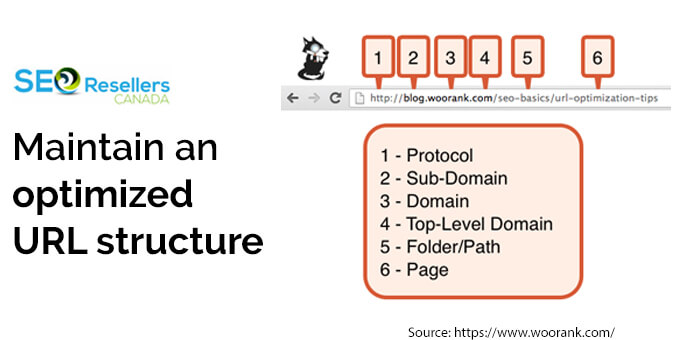
Even though we have briefly mentioned adding keywords in the URL previously, the information is worth mentioning again. Why? Because adding keywords in the URL ensures that your content is appropriately set up for SEO marketing strategy.
Here is a fictional website example –
- Your official website domain is www.pawsandmore.com
- The URL for the blog page’s website should be www.pawsandmore.com/blog/
- The URL for blog content that talks about puppy food for dogs must appear www.pawsandmore.com/blog/puppy-food-for-dogs
And since URLs are permanent, it is best to choose a URL-friendly system because changing a URL is like starting the SEO from the ground up. With a URL-friendly system, you can prevent any sudden drops in organic ranking and traffic when initiating a change.
Also, when updating an URL, ensure that the old URL is redirected to the new one. This way, any link attached won’t get disappeared.
4- Review and maintain the core vitals of your website
Similar to how you would visit a physician to check your core vitals, you need to do the same with your website, too. The notion is to prevent any unnecessary issues with the website.
Why does reviewing and maintaining the core vitals of your website matter?
Well, SEO has been around for a while now. This means there are tons of content out there, and simultaneously tons of content is being posted on a regular basis. This results in Google having an increasingly tough time comprehending which content to give the first spot. Hence, it uses core web vitals and page experience to differentiate between the SEO winners and losers.
Nowadays, local SEO strategy is not just limited to placing keywords. It involves page loading speed, content format, design and user behaviour – such as bounce rates and time spent on the page.
In short, the sustainable success of a new website SEO strategy no longer ends with a click. You need to satisfy the readers wholeheartedly while they are on the page.
Simply copy and paste your domain into PageSpeed Insights to obtain a comprehensive report on your website’s core vitals and speed. Even though the report may seem highly technical, the simple English language used helps identify the errors and comprehend the suggestions easily.
5- Maintain accessibility, and don’t forget to promote
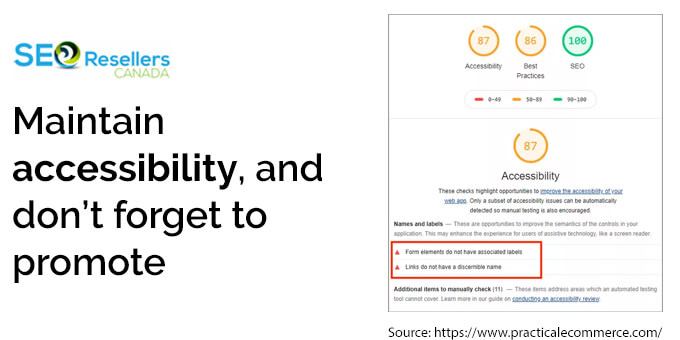
Accessibility means how easy it is for your users to use the website – whether it is in regards to finding information or purchasing something from you. This element has a key role in the ranking factor. Hence, making the site accessible should be a priority.
Besides ensuring the content is being indexed and crawled properly, you can take a few steps to make the site highly accessible –
- Maintain a healthy colour contrast – one that is easy on the eye and attractive.
- Label elements like buttons should be labelled correctly.
- Images must feature an alt text so screen readers can comprehend them.
- Ensure the font size is big enough for easy reading.
- Focus on mobile SEO strategy and make the site device-friendly, too.
Lastly, don’t just publish content and sit idle. When it comes to SEO, “build it and they will come,” never provides any profitable outcomes.
You will require putting in some effort to make the content visible. Perhaps harness the power of visibility from places you have a strong presence. Maybe your social media is alive and flooded with followers, likes, and shares, or your email list is active. Irrespective of which channel you use, the idea is to use it to drive more traffic to the website. Not only will this boost your SEO efforts, but it will showcase your brand as an authoritative site because more people are spending time on it.
And suppose you aren’t receiving enough traction with the SEO efforts, you can focus on paid ads to leverage your SEO strategy for ecommerce websites.
6- Signing off
Even though creating an effective SEO marketing strategy is a challenging process, it isn’t impossible. Your decision to work with an SEO strategy agency like SEO Resellers Canada can go a long way. In fact, with the SEO experts at your aid, you would be able to make a more sound decision in regard to your new website.
Just keep in mind that SEO is an ongoing process and not a done-and-dusted strategy. Ensure you and the chosen experts work together to tweak things every now and then. And whatever you do, ensure to maintain a strong website structure – one that makes scaling and accumulating relevant data an easy task.












